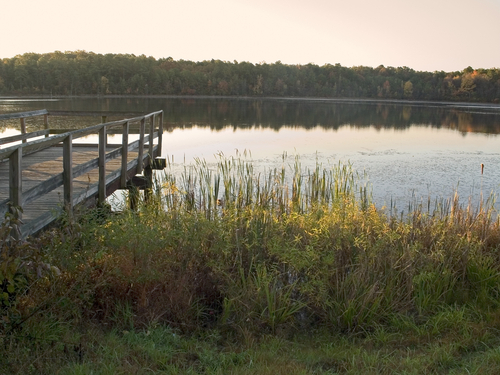Inspecting Forester Perspective - The Challenges of Working in the Garden State
 If you think about America’s most densely populated state, New Jersey, you probably think
If you think about America’s most densely populated state, New Jersey, you probably think
about what you’ve seen from the New Jersey Turnpike: commuter suburbs, heavy urban development, oil refineries, industrial parks and the occasional glimpse of farms and
other rural areas.
You would probably never guess that 42 percent of New Jersey is covered in forestland, and that there are more than 300 Tree Farms in the state. These properties range from small woodlots to large, multigenerational cranberry farms of southern New Jersey. Most Tree
Farms in the state, though, are less than 200 acres.
Being a Tree Farmer in this state has always presented complex challenges. Land is expensive—up to a quarter of a million dollars per acre in some parts of the state. There
are few wood markets and they are mostly located in neighboring states.
“New Jersey, when it comes to wood markets, is a conundrum,” says Dennis Galway, a consulting forester and Vice Chair of the New Jersey Tree Farm Committee. “We have a whole range of complex interrelated parts that present hard-to-solve problems.”
Some of New Jersey’s problems are common to Tree Farmers across the United States. Proliferating white-tailed deer, which prefer a diet of native plants over non-native vegetation, have compromised the state’s oak forests and caused populations of invasive plants and trees to explode. “There were virtually no white-tailed deer in New Jersey in the 1970s, and now we have 50 to 150 deer per square mile,” notes Galway. “They eat the native vegetation down to the ground. We may be moving toward a forest that’s entirely non-native and invasive species.”
And then there are the timber markets—or rather, the lack of timber markets. “On the one hand,” Galway says, “we have great, high-quality wood. But it is very difficult for us to sell. Housing starts are way down, and we face competition from cheaper foreign products like
bamboo. The only market that has held its own is firewood.” Because there is only one commercial sawmill, a few specialty mills and just a handful of loggers, New Jersey Tree Farmers have the added expense of shipping the timber or pulp they harvest to mills in New
York, Pennsylvania, Maryland or Delaware for processing.
These difficult market challenges have become even more daunting in the wake of four mega-storms that have slammed New Jersey’s forests. Three storms in 2011—Hurricane
Irene, Tropical Storm Lee and a freak heavy snow in late October—brought down huge numbers of trees. Then came the devastation of what Galway calls “Frankenstorm
Sandy,” which not only destroyed large sections of the New Jersey shore, but also wreaked havoc on Tree Farms that had still not recovered from the three previous weather disasters.
“Sandy was just devastating,” Galway says. “The storm downed tens of thousands of trees, inundating the already small market for New Jersey timber. It’s a big challenge to get rid of all that wood. I’ve been working almost nonstop for my clients since the storm. First it was
clearing out the driveways. Now it’s clearing out the woods and trying to find markets so the wood doesn’t just rot. We don’t have enough people and enough markets to handle such an overwhelming, historic event.”
Unlike homeowners along the New Jersey shore, who are likely to receive government or insurance assistance to help cover their losses, “forest landowners will not get any compensation for the damage Sandy caused, unless a tree happened to fall on their house, car or fence.”
“The emotional impact of the storms has been considerable,” he notes. “But, like the trees they love, Tree Farmers are strong and resilient and will recover. The fact that they’re willing to pay to clean up and restore their woodlands symbolizes their love for and commitment to
their land.”










Comments: